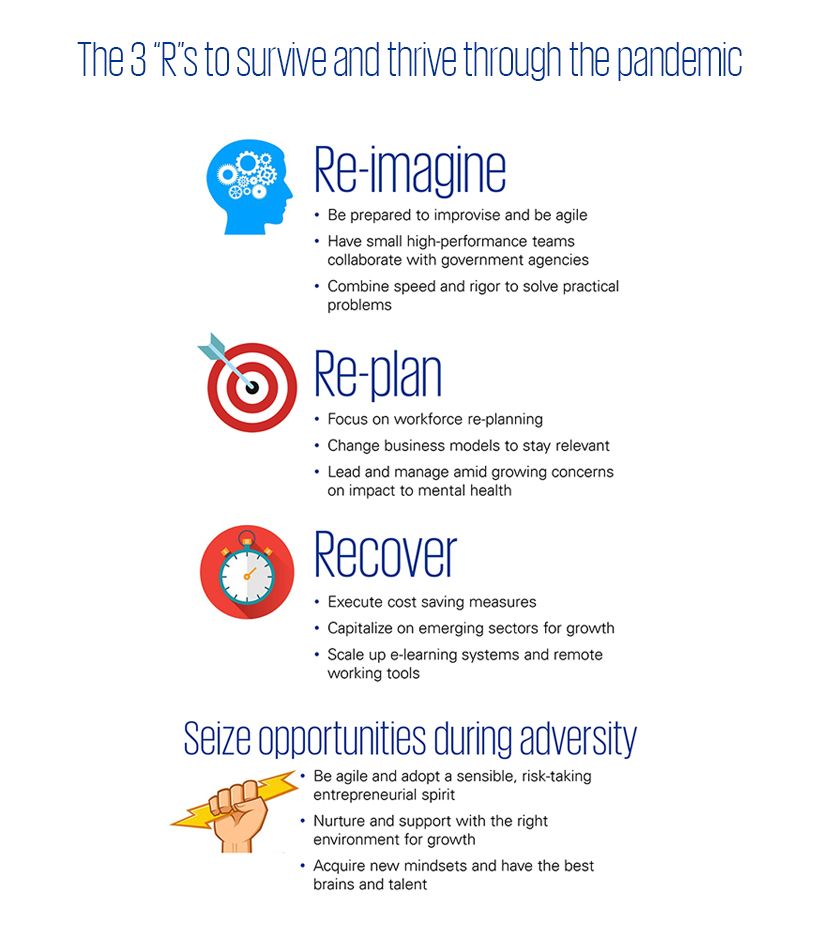Reimagining a post-COVID world with agility and resilience
By Ong Pang Thye and Dr Yap Kwong Weng

The COVID-19 pandemic has left us with an unpredictable and fluid economy ahead. We are entrenched in a global crisis that is spiralling into a recession not many have experienced in their lifetime. Since end-2019, the COVID-19 pandemic has infected more than 4 million people globally, taken hundreds of thousands of lives and paralyzed global supply chains. In a matter of weeks, sectors such as aviation, tourism, retail, manufacturing and construction are struggling with falling demand or disruption to their operations as a result of the various governmental measures to contain the spread of COVID-19.
Business leaders need to take a leap of faith by reimagining the future, re-planning their strategies and adopting an entrepreneurial mindset for recovery. In the post-COVID environment, new risks and waves of innovation will emerge. Some of the immediate needs, for example, are effective and cost-efficient cleaning services and increased automation and efficient techniques in the construction sector. How can the workforce keep up with longer-term structural changes when the economy rebounds? How can companies deal with increasing global risks and increased capital investments? This depends on the effectiveness and agility of corporate strategy and government policies.
In the past few months, technology enablers have been used to manage some of the immediate challenges such as contact tracing. More innovation is expected to emerge as we move to new ways of working and living. In Singapore, robots have been deployed in community care facilities for disinfecting facilities, delivering food and carrying out health checks. As innovation in technology takes place, history teaches us some lessons on past crisis interventions.
Researchers who studied the 1918 Flu Pandemic concludei that countries that intervened earlier and more aggressively experienced a relative increase in real economic activity after the pandemic subsided.1 Studies have shown that the pandemic had directly hurt economic growth after it was estimated to have killed over 50 million people globally. Using geographic variation in mortality, economists found that the more exposed areas experienced a sharper and more persistent decline in economic activity with an 18% reduction in manufacturing output in post-crisis times. For now, consumer demand will not recover to pre-COVID-19 levels due to lost wages, investment losses, and shattered confidence. Global supply chains will remain sluggish and cheap capital will struggle to find early takers as momentum slowly builds up due to excess capacity.2
As such, we can expect a bumpy ride ahead with uneven, lower economic growth and increased global uncertainties post-COVID-19. However, there is cause for hope ahead if business and government leaders act fast to address and reengineer their business models, especially for industries that can accelerate – now. Both business and government leaders will have to work closely together to devise novel solutions and improvise existing ones to make the best of the evolving situation.
For most companies, it won't be back to business as usual. Without realizing it, some leaders will draw on past experiences, some will engage in groupthink practices, and others will take up the role of the crisis leader and make reactive decisions based on circumstances. Those who get it right will see quick returns but there is little room for complacency in the near term. The impact of COVID-19 will stay with us for a long time. We can manage and reduce the risks of transmission but can’t fully eliminate it.
How firms can tackle the pandemic
In order to survive and thrive post-COVID-19, business leaders need to use fresh strategic framing and create organizational structures that promote agility. While certain sectors will suffer, others will survive and thrive. The market will reward businesses that can deploy their products and services with agility. Since start-ups are innovating to solve the business and infection problems caused by COVID-19, it is timely for companies to start collaborating with these start-ups and best expertise around the world, including universities and leveraging Generation Z talent to reinvent themselves. Business leaders will need the courage to embrace and experiment with ideas outside our comfort zone by adopting these considerations:
Re-imagine
First, a deeper reimagination of strategic responses using improvisation and agility. Such a response can be best designed by small high-performance teams with government agencies to leverage and reframe the Industry Transformation Maps (ITMs) as a basis for developing post-COVID-19 ideas with the aim to combine speed and rigor to solve practical problems. Companies and government agencies can ride on the collective wisdom of the New Emerging Taskforce providing recommendations to the Future Economy Council.
Re-plan
Second, focus on workforce re-planning. Most companies are compelled to change their business models in order to stay relevant and survive in a post-COVID-19 world. Telecommuting was until recently not imaginable, but as we prepare to go back to work after the circuit breaker period, many organizations with the ability to do so, are planning to make telecommuting a feature of working. Companies can minimize transmission risk while trading office space rent for other competing investments. According to KPMG’s Global Strategic Research’s Sensory Advantage Ecosystem, we are seeing rapid and large-scale shifts to remote work, which raises new concerns about client and data protection. With a surge in the adoption of collaboration technology across sectors, there is also focus on business leaders’ skills to lead, manage and engage effectively with their team members, amid growing concerns on impact to mental health and social connection rise as immediate issues.3
Recover
Third, leverage government support to accelerate growth for faster recovery. On 28 April 2020, the Monetary Authority of Singapore announced that Singapore will enter into a recession this year, due to the COVID-19 pandemic, resulting in job losses and lower wages. Despite government financial support packages, unemployment rates are expected to rise as companies execute cost saving measures. The government can provide more support on developing new capabilities, capitalizing on emerging sectors based on demands during COVID-19. Some examples include scaling up e-learning systems in the education sector, implementing collaborative online tools to aid remote working and automated food security alert and response systems with predictive elements.
Seize opportunities during adversity
Finally, there are varying degrees of risk exposure to COVID-19 driven shifts that will result in various recovery patterns. Supply chains will likely become more agile and modular as companies seek to diversify their resources to minimise risks in business operations disruption in the event of another ‘black swan event’. All this comes with a wave of new unleashed innovation, agility and risk-taking of entrepreneurs, exploring and pivoting into new areas. This is an opportunity for Singapore entrepreneurs to create the next Singapore brand in critical sectors, such as pharmaceutical, technology and food.
The expected fallout from failed companies or down-sized operations will create higher unemployment, potentially affecting blue and white-collared workers. We see this group as the impetus to create the next Singapore brand or icon, if nurtured and supported with the right environment. Many of these resources could become our new generation of entrepreneurs creating novel solutions to create change and serve public good, and this can be enhanced through a tax-free zone or sandboxes to encourage agile thinking. However, for this to happen, the right support structure and eco-system will need to be created with the government taking a leading role. It will require new mindsets and a combination of the best brains and talent, young and old.
We are indeed at war now against an invisible and persistent enemy that will continue to plague us until an effective vaccine is developed and globally distributed. This is the time for companies to make structural changes in their business models because the world has fundamentally changed and there is no turning back. We must hold on to the dreams that brought us this far.
Ong Pang Thye is the Managing Partner of KPMG in Singapore. Dr Yap Kwong Weng is Principal Advisor of KPMG in Singapore and Executive Director of the KPMG-A*STAR Joint lab.
The opinions expressed are those of the authors. They do not purport to reflect the opinions or views of KPMG in Singapore.
i The authors study the economic effects of the largest influenza pandemic in U.S. history, the 1918 Flu Pandemic which lasted from January 1918 to December 1920 and spread worldwide. It is estimated that about 500 million people, or one-third of the world’s population, became infected with the virus, leading to at least 50 million deaths worldwide, with 550,000-675,000 occurring in the United States. The pandemic thus killed about 0.66 percent of the U.S. population, and resulted in high death rates for young (18-44) and healthy adults. They conclude that (1) Non-pharmaceutical interventions (NPIs) such as social distancing can have positive effects on the economy, through limiting spikes in infections and avoiding mass casualties. (2) A study of the economic impact of the 1918 Spanish Flu in the US has found those cities that implemented early and extensive NPIs suffered no adverse economic effects over the medium term. (3) Cities that intervened earlier and more aggressively actually experienced a relative increase in real economic activity after the pandemic subsided.
1 World Economic Forum article on the Spanish Flu.
https://www.weforum.org/agenda/2020/04/pandemic-economy-lessons-1918-flu/.
2 KPMG Global SAE analysis. “Resilience Phase”, pg.4.
3 KPMG Global SAE analysis. “Ways of Working”, pg.7.
Connect with us
- Find office locations kpmg.findOfficeLocations
- kpmg.emailUs
- Social media @ KPMG kpmg.socialMedia



